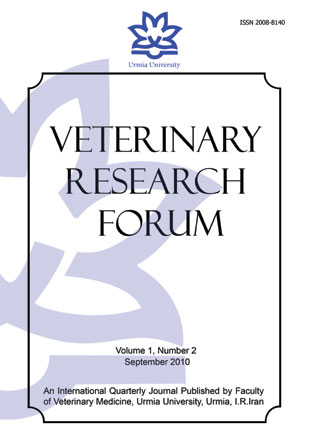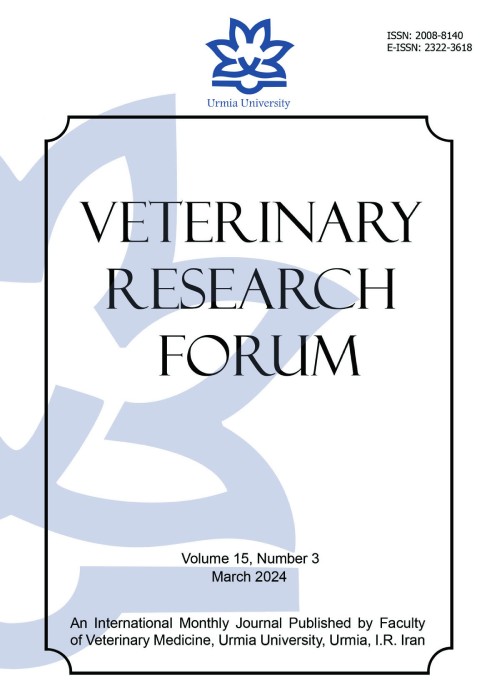فهرست مطالب

Veterinary Research Forum
Volume:1 Issue: 2, Summer 2010
- تاریخ انتشار: 1389/07/15
- تعداد عناوین: 9
-
-
Page 59
-
Page 65A feeding trial of 120 days duration was conducted to study the effect of replacing 20 and 25 % of camel ration by poultry litter (PL) on the performance and some blood biochemical parameters. Fifteen healthy one–humped camels were allotted into three groups (5 animals / group). The first group was fed a basal ration and considered as control, while the second and third groups were fed rations in which poultry litter replaced 20 and 25 % of the basal ration. There was no significant differences in the dry matter intake and digestion coefficients of dry matter and ether extract between the different groups and camels fed on ration containing poultry litter had significantly (P < 0.05) decreased daily gain and feed conversion compared to the control. The apparent digestibility of crude protein by camels increased with 20 % poultry litter in the ration compared with other treatments. Digestibility of crude fibre was higher in rations containing poultry litter compared to control one. No significant differences were observed in blood biochemical parameters except urea and uric acid concentrations were significantly (P < 0.05) higher in the serum of animals fed on poultry litter.In general, it could be concluded that, dried poultry litter can be utilized efficiently and safely in rations of camels up to a level of 25 % without adversely effect on performance.
-
Page 73Rapid detection and differentiation of infectious bronchitis virus (IBV) involved in the disease outbreak is very important for controlling disease and developing new vaccines. In the present study, three regions of the genome of IBV vaccine and field isolates including S1 gene, gene 3 and nucleocapsid (N) gene along with 3' untranslated region (3' UTR) were amplified and subjected to restriction fragment length polymorphism (RFLP) using three different endonucleases. Amplicons from S1 gene and N-3’UTR generated four RFLP patterns, grouping IBV strains into four similar groups, while amplicons of gene 3 generated three RFLP patterns classifying examined IBVs in different groups from those of S1 and N-3' UTR. 4/91 strain and MNS-7862-1field isolate both belong to 793/B serotype were differentiated from each other based on gene 3, N-3’UTR and S1gene. IBVs belonged to different serotypes showed different RFLP patterns based on RFLP patterns of all three regions. S1 gene and N-3’UTR RFLP analysis differentiated IB88, MNS-7862-1 and 4/91 from each other. This is the first report on the molecular analysis of the gene 3 for IBV strain differentiation. Our results revealed that RFLP analysis of N-3’UTR and S1 gene had the higher discriminatory power than gene 3. None of the RFLP patterns of different regions differentiated 4/91 vaccine strain from its field isolate.
-
Page 83In the present study, the effects of intra-hippocampal microinjections of morphine (an opioid agonist) and naloxone (an opioid antagonist) were investigated in the formalin-induced orofacial pain in rats. Orofacial pain was induced by subcutaneous injection of formalin (1 %, 50 μl) in the upper lip region and the time spent of face rubbing was measured in 3-min blocks for 45 min. Formalin induced a biphasic (first phase: 0-3 min; second phase: 15-33 min) pain response. Intra-hippocampal microinjections of morphine at doses of 2 and 4 μg significantly (P < 0.05) attenuated the first phase, and at doses of 1, 2 and 4 μg, morphine significantly (P < 0.05) suppressed both phases of formalin-induced orofacial pain response. Intra-hippocampal microinjections of naloxone (1 and 4 μg) non-significantly increased pain when used alone, and in pretreatment microinjection, naloxone (4 μg) reversed morphine (2 μg)-induced antinociception. These results indicate that at the level of hippocampus of the brain, morphine through a naloxone-reversible mechanism produced an antinociceptive effect confronting the pain induced by formalin in the orofacial region in rats.
-
Page 91To evaluate the correlations of the serum concentrations of trace elements with lipids and lipoproteins in water buffalo (Bubalus bubalis), the serum concentrations of cholesterol, triglyceride, total lipids, very low density lipoproteins (VLDL-cholesterol), low density lipoproteins (LDL-cholesterol) and high density lipoproteins (HDL-cholesterol) and their correlations with serum concentrations of copper, zinc, selenium, iron and manganese were measured in 100 clinically healthy water buffaloes. Serum concentration of copper had a significant correlation with HDL-cholesterol (r = 0.467, P < 0.01). Serum total lipids had a significant correlation with iron (r = 0.25, P = 0.019) and the correlation between total lipids and manganese was marginally significant (r = -0.197, P = 0.07). Additionally, separate evaluation of age groups showed that serum cholesterol had a significant correlation with copper (r = 0.643, P = 0.007) in buffaloes up to 2 years of age and with zinc in animals between 2-5 years old (r = -0.382, P = 0.049). Serum selenium had a significant correlation with VLDL- cholesterol (r = 0.345, P = 0.049) in buffaloes more than 5 years old.
-
Page 99Growth inhibition of Aspergillus fumigatus,Aspergillus flavus and Fusarum solani exposed to the essential oils including Thyme, Agastache and Satureja were studied. Disc Diffusion Method was used to evaluate the fungal growth inhibitory effects of the essential oils. Minimal inhibitory concentration (MIC) and minimal fungicidal concentration (MFC) of the oils were determined and compared with each other. The results showed that all three essential oils examined, had antifungal effects against three fungi species. The MIC data revealed that Thyme oil was the most effective essential oil with the MIC of 62.5 μl ml-1.
-
Page 107Despite promising results observed using silicone rubber chamber, no previous comprehensive work was performed on behavior of the conduit. Present study aimed at further functional, histomorphometrical and immunohistochemical assessment of nerve regeneration in the same animal along a 10-mm rat sciatic nerve gap. Fifty- four male Wistar rats were divided into three experimental groups (n = 18), randomly: Sham-operation (NC), Transected control (TC) and silicone conduit (SIL). In NC group after anesthesia left sciatic nerve was exposed through a gluteal muscle incision and after haemoestasis the muscle was sutured. In TC group left sciatic nerve was exposed the same way and transected proximal to the tibio-peroneal bifurcation leaving a 10-mm gap. In SIL group left sciatic nerve was transected the same way and proximal and distal stumps were each inserted into a silicone tube. Each group was subdivided into three subgroups of six animals each and were studied 4, 8, 12 weeks after surgery. Functional analysis showed significant improvement of nerve function in SIL group than in TC group (P < 0.05). Morphometric indices and immuohistochemistry indicated there were significant differences (P < 0.05) between SIL and TC groups 12 weeks after surgery. Silicone entubulation technique has offered the hope of providing a method for achieving the peripheral nerve regeneration in the least harmful way that is available, easily performed. Using silicone tubes in bridging of nerve defects could be promising because it is inert and does not induce extensive scarring or degeneration after implantation.
-
Page 117Anaplasma bovis is a leukocytotropic agent of bovine anaplasmosis and there is no available information about molecular study on this agent in cattle of Iran. In this study a total 150 cattle blood samples were collected from central part of Iran. The presence of A. bovis examined using light microscopic detection and species-specific nested polymerase chain reaction (nested-PCR) based on 16S rRNA gene. Of the 150 cattle, 4 (2.66 %) was positive for A. bovis by nested-PCR. These data is the first A. bovis DNA presence in cattle from central part of Iran.
-
Page 123This study was performed from February to April 2006; several visits were made to abattoirs in the north of Iran for Hypoderma spp infestation. Necropsy inspection of slaughtered and skinned animals were carried out by examination of the inner skin surface and subcutaneous tissues. Warbles were isolated by squeezing nodules from subcutaneous tissues. In the case of abscess presence, aseptic sample were taken from abscesses. The parasitological and bacteriological examinations were performed on the samples. The results indicated that 104 out of 958 of slaughtered animals were infested to Hypoderma spp in which 48 (46.15 %), 34 (32.69 %) and 22 (21.15 %) were infested to Hypoderma bovis, Hypoderma lineatum and both species, respectively. Following bacterial analysis, the following bacteria were isolated: Escherichia coli, Streptococcus pyogenes, Staphylococcus aureus, Staphylococcus epidermidis and Klebsiella pneumonia.


